

This chapel (to the right of the apse) stands on the site of an earlier church. The articles referenced below summarise the scholarship that suggests that this was the church of SS Cassian and Callistus in which St Fortunatus was buried in the 6th century and in which his relics were formally recognised in 708. The translation of 708 might have been associated with the building of a larger church on the site.
The earliest certain documentation of a church dedicated to St Fortunatus in Todi is in a bull of Pope Celestine III (1191-8) in which he lamented the decadence of the monks of the adjoining Benedictine monastery. As a result, the monastery passed to the Congregazione di Fonte Avellana.
In 1198, Pope Innocent III dedicated an altar in the church to St Fortunatus, while the Bishop of Porto dedicated another to St Cassian.
By 1235, the monastery had once more fallen into decadence, and Pope Gregory IX transferred it to the Vallombrosians. In 1254, they were required to cede it to the Franciscans in exchange for the church of Sant' Arcangelo delle Fontanelle (outside Porta Fratta).
The church remained in use for a short time after Pope Nicholas IV laid the foundation stone of its successor in 1292. In 1296, it was necessary to demolish part of tit in order to build the apse of the new church to the left of it. It was subsequentl adapted to form the Cappella Gregoriana of the new church.
It was during this work that the relics of SS Fortunatus, Cassian and Callistus were rediscovered in the old church. Pope Boniface VIII consented to their translation to the sacristy of the new church in 1297.
Remains from the Earlier Church
[Bifore window (12th century)]
Water stoup (6th century)
The water stoup near the entrance to the sacristy (to the left of the apse) was made from an architectural fragment decorated with a cross that must have come from an ancient church on the site.
Lions (8th century ?)
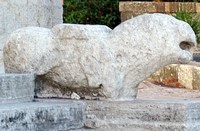
These two lions on the steps in front of the facade probably came from an earlier church on the site.
Architectural Fragment (ca. 1100)
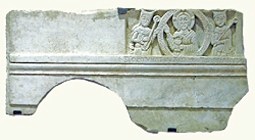
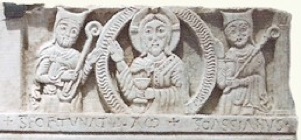
This marble facing was discovered in 1993 near San Fortunato. The inscription under the carved figures identifies:
-
✴the central figure of Christ in a mandorla by the letters alpha and omega; and
-
✴the bishop saints to the sides as St Fortunatus (on the left) and St Cassian (on the right).
The relief is now in the Museo della Città.
Cappella Gregoriana
Detached Frescoes (14th century)
Two frescoes here that were detached from the cloister are signed by Nicolò di Vannuccio and dated by inscription:
-
✴the Maestà with angels (1373); and
-
✴the Maestà with saints (1400).
The latter, which is in a niche to the left of the back wall, depicts the Madonna and Child enthroned, with figures of the Annunciation on the sides of the throne and God the Father above. Figures of SS John the Baptist and Bartholomew decorate the sides of the niche.
Four damaged frescoes here that were also detached from the cloister are attributed to Nicolò di Vannuccio. They depict:
-
✴the Madonna with souls in purgatory under her cloak;
-
✴the Madonna and Child with SS Michael and Antony Abbot;
-
✴the Madonna and Child with St James and another saint; and
-
✴the Madonna and Child with SS James and Michael.
Coronation of the Virgin with saints (1618)
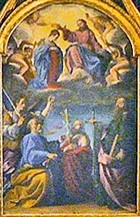
The altarpiece was moved here in 1758, following the acquisition of the current Baroque altar from Foligno.
Art from the Cappella Gregoriana
Madonna and Child with angels (1432)
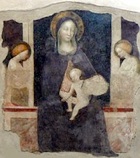
Read more:
M. Castrichini et al. (eds), “Il Tempio del Santo Patrono: Riflessi Storico-Artistici del Culto di San Fortunato a Todi”, (1988) Todi contains two particularly relevant articles:
E. Menestò, “ ‘Nec Fortunati Tudertini Acta Silenda’: Appunti tra Storia e Agiografia”, pp 7-34
E. Paoli, “ ‘Nobile Depositum Tuderti’: Il Culto e il Tempio di San Fortunato nella Vita Religiose di Todi”, pp 35-66
Return to : Main page on San Fortunato
Return to the Monuments of Todi.

